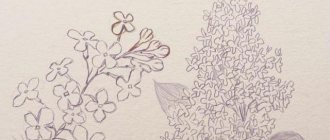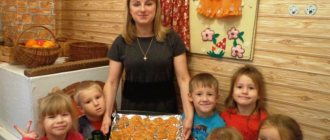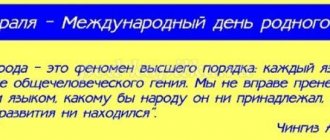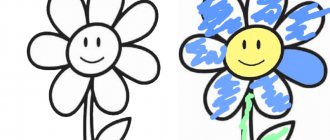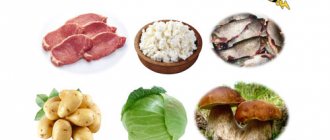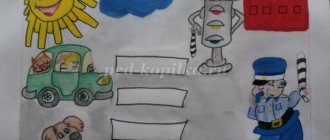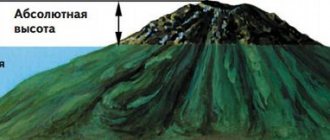lesson notes “My favorite city”
7
Municipal budgetary preschool educational institution “Kindergarten of a combined type No. 12 “Little Red Riding Hood”.
Abstract of GCD in the preparatory group for moral and patriotic education
"My favorite city".
Prepared by: Safronova T.Yu.
Teacher I quarter categories
Berdsk 2017
Target:
to clarify children’s knowledge about the country in which they live, about their hometown of Berdsk, and its attractions. Develop curiosity, broaden your horizons, enrich and activate your vocabulary. Instill love for your hometown.
Tasks:
—
Expand children's understanding of the features of their hometown;
—
To consolidate children’s knowledge about their hometown (its past and present), its attractions, and significant public institutions;
— To cultivate respect for the cultural traditions of one’s people, a sense of pride in one’s native country, its achievements, and culture;
— Exercise in the development of coherent monologue speech, consolidate the ability to answer the teacher’s questions with a complete answer;
— Enrich the vocabulary with new words related to events in social life.
Equipment:
multimedia installation, slide presentation, audio recording with songs about the city, paper, glue.
Progress of the lesson:
Educator: Guys, I have a surprise for you. What do you think might be in this box?
Children: Children's answers.
(The teacher opens the box, and there is a balloon).
Educator: Guys, look, this is a balloon. He came to visit us from his city “Magic Balls”. Let's get to know him (children take turns saying their last name and first name).
Educator: Ava know that the ball flew to us from another city. He has never been to us and does not know the name of our city. WHAT ARE THE STREETS WE HAVE AND WHERE WE CAN RELAX AND PLAY. Shall we tell him?
Educator: Guys, what is the name of the country in which we live?
Children: Children's answers.
Educator: What language do we speak?
Children: Children's answers.
Educator: Each country has its own main city or capital. Russia is a country. What is the name of the capital of Russia?
Children: Children's answers.
Educator: That's right, guys. You and I live in Russia. And in our country there are many cities and regions. What is the name of our city in which we live?
Children: Children's answers.
Educator: In what area is it located?
Children: Children's answers.
Educator: Why is it called Novosibirsk?
Children: Children's answers.
Educator: Guys, our city Berdsk is located in the Novosibirsk region of Russia
, Berdsk is a satellite of Novosibirsk.
Founded in 1716 on the Berd River
as the
Berdsky fortress
.
The name of the city is derived from the name of the river on which it stands,
and most likely has Turkic roots.
The word “berdu” (“birdu”) in Turkic languages means “take” or “taken.” The Berdsk fort was used as a stronghold for the advance of the Russian conquerors of Siberia to Altai. The prison was a reliable defense, since nature created a miracle triangle around it: the Ob flowed on one side, the Berd on the other, and the third was protected by a centuries-old pine forest. After some time, a settlement grew around the fortification, where people engaged in fishing, trade, and crafts began to settle. The posad soon became the administrative center for the surrounding villages. In connection with the construction of the Novosibirsk hydroelectric power station and the flooding of the city’s previous location in 1954, Berdsk was moved to a new location, which is why it is called “twice-born”
. Intense work on resettlement went on for 4 years, and was completed in 1957. After which the rapid development of our city began.
Summary of an educational lesson in a preparatory group on the topic: “My hometown”
Summary of educational lesson
in the preparatory group on the topic: “My native city”
Target:
Expand and generalize children’s knowledge and ideas about their city, its historical past, memorable and remarkable places in their city, people who glorified their city - artists, poets, athletes, etc. Activate children's cognitive interest, attention and memory, develop logical thinking and imagination; enrich vocabulary, develop children’s coherent speech; to cultivate a caring attitude towards the history of one’s native city, to cultivate a sense of respect for those who glorified their city; encourage you to strive to study in such a way as to glorify your city in the future.
Vocabulary:
townspeople, symbols, coat of arms, fortress, monument, guide, landmark, problem, architect, famous, famous, talented, architectural, memorable, glorify, strive, cherish, appreciate.
Materials and equipment for the lesson:
cards with words according to the number of children, a map, coats of arms and symbols of your city and other cities, slides with the sights of the city, memorable places, photographs of these places, photographs of famous and famous people of the city, sheets of paper, brushes, paints, pencils for drawing.
Preliminary work:
- Project activity “Native and beloved land” (acquaintance with the history of the native land)
- Excursion to the memorable places of your city; to the city's local history museum
- Conversation with children about the city and the people who glorified it
- Drawing “My Street”, application “My City” (collective)
- Reading poems about your hometown, works of local poets and prose writers.
Working with parents:
- Folder – movement “Our fellow countrymen”
- Consultation “How to introduce children to their native land”
Progress of the lesson:
IN:
Guys, how old are you? How old are your mothers? Dads? Grandmothers? Grandfathers? All people are of different ages. Do you think cities have an age or are they all the same age? How old is our city? (children's answers)
IN:
Guys, are all cities the same or are they different from each other? How to distinguish one city from another? (children's answers).
IN:
By what signs would you recognize your hometown? (children's answers)
IN:
Show it on the map (children show it). What are the people of our city called? (children's answers)
IN:
If you now arrange the word cards in order, you will find out what the word city means:
IN:
How could cities be protected in ancient times? (children's answers). Was our city fenced with a fortress? Why? (children's answers).
IN:
It seems to me that you know a lot about your city. In this case, I want to invite you to the curious club for the game “What? Where? When?" Do you agree? (Yes). Then divide into 2 teams of experts. Captains, take your seats. Now we find out whose team knows more about their city. I will ask you questions. Whose team is faster and, most importantly, answers the question correctly will receive a point, which will be awarded by the jury. At the end of the game, our jury will count the points of each team and name the winner of today's game. Please come up with names for your teams.
IN:
The first task for the teams: tell us what was remarkable about our city in the past, what the people who lived in it did (children’s stories, the jury awards points to the teams).
IN:
The second task for the teams: What will replace what our city is currently known for? (children's stories).
IN:
You know that each city has its own coat of arms, its own symbols. Our city has all this.
D/i “Find and name” (coat of arms, symbols of our city among others). Children explain their meaning. The jury awards points to the teams.
IN:
And now I invite you on a tour of my hometown. We will get acquainted with architectural monuments and visit cultural recreation areas of the townspeople. You will be the only guide. But first you need to check whether you know these memorable places in your city well in order to be a tour guide. I will show you slides with famous places of our city, and you watch and remember. The team that remembers and names them the most will win and earn an extra point (d/i “Remember and name”). They will be the first to conduct the tour.
IN:
Now look at the photographs and choose a place in our city that you will tell us about. (Children choose a photo and talk about the sights of the city, the jury evaluates the children's stories).
IN:
Well, our tour of the memorable places of our city has ended. We "drove" along different streets. Do you remember their names? Let's play the game "Who can name the most streets of their city." The team that remembers the most names is awarded a point.
IN:
Now think about what is good for our streets and what is bad. (D/and “Good - bad” TRIZ).
IN:
Many famous and famous people lived and live in our city. Choose a photo of a person you know and tell us what he became famous for and what he did for our city. (children's stories, the jury awards points to teams).
IN:
Do you think our city has any problems? How can they be solved? (children's answers).
IN:
And now a competition of poems about our city is being announced. (children's answers).
IN:
Well, guys, how much, it turns out, you know about your hometown, how much you love it. Let's think, dream, how will you be useful to your city when you grow up? (children's stories).
IN:
Now let's listen to our jury, who will sum up the results and name the team that will win today's game.
The jury announces the winners and awards prizes. The teacher invites the children to draw their favorite city for the exhibition of children's drawings “My Native City”.
